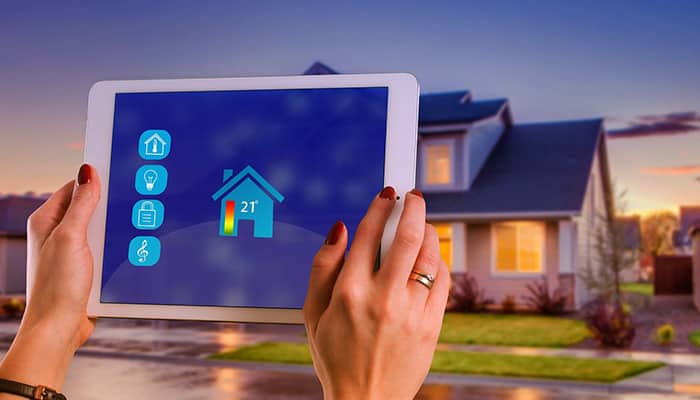Transform Your Space with IFTTT: The Ultimate Guide to Smart Home Automation

Welcome to the world of smart home automation! If you’re not already familiar with the term, it’s essentially the idea of using modern technology to simplify and streamline your everyday life. One of the key players in this field is IFTTT, or “If This, Then That”. While it might seem complicated at first, the beauty of smart home automation and IFTTT is that they’re designed to be user-friendly. You don’t need to be a tech wizard to get started – all you need is a device with internet access and a little bit of curiosity. Ready to dive in? Let’s explore the world of IFTTT and smart home automation together.
How IFTTT Works: An Overview

At the heart of IFTTT is the simple concept of ‘If This, Then That’. The ‘This’ refers to the trigger, which is the condition that must be met for the action, or ‘That’, to occur. For example, ‘if I leave home, then turn off the smart lights’.
To create an applet, you first select a service (like your smart lights or security camera), define a trigger, and then decide on an action. Once set up, the applet runs in the background, waiting for the trigger condition to be met before executing the action.
The beauty of IFTTT lies in its simplicity and flexibility. You can create applets that control a single device or several devices simultaneously. Moreover, with hundreds of compatible services, the possibilities are virtually endless.
The Benefits of Smart Home Automation with IFTTT

Smart home automation, particularly with IFTTT, has numerous benefits. First and foremost, it enhances convenience. Imagine your coffee maker automatically brewing a cup of coffee as soon as your morning alarm goes off, or your thermostat adjusting the temperature based on the weather forecast. This level of automation not only makes life easier but also saves time. Here is a list of 10 benefits:
- Increased Efficiency:
- IFTTT allows you to create automated sequences of actions based on triggers. This increases efficiency by eliminating the need for manual control of various devices. For example, you can set your lights to turn off automatically when you leave home.
- Seamless Integration:
- IFTTT supports a wide range of devices and services. This means you can integrate different smart home devices, regardless of their brand or type, into a unified and cohesive system.
- Customization:
- Users have the flexibility to customize their automation according to their specific needs. IFTTT allows you to create personalized applets, giving you control over how your devices interact.
- Time and Energy Savings:
- Automation can save time and energy by handling repetitive tasks. For instance, you can create routines that adjust thermostat settings, turn off lights, and lock doors when you go to bed.
- Enhanced Security:
- IFTTT can enhance home security by integrating with security systems and cameras. You can receive alerts, trigger sirens, or even turn on lights in response to detected motion.
- Remote Control:
- With IFTTT, you can control your smart home devices remotely. Whether you’re at work or on vacation, you can monitor and manage your home automation system through the IFTTT app.
- Integration with Online Services:
- IFTTT enables integration with various online services, extending automation beyond your immediate smart home environment. You can, for example, receive notifications or update your calendar based on specific triggers.
- Energy Efficiency:
- Smart home automation, coupled with IFTTT, can contribute to energy conservation. You can automate the adjustment of thermostat settings, turning off lights when not needed, and controlling other energy-consuming devices.
- Voice Control:
- Many smart home devices are compatible with voice assistants like Amazon Alexa or Google Assistant. IFTTT can be used to create custom voice commands, allowing for even more natural and personalized interactions with your smart home.
- Simplified Daily Tasks:
- IFTTT simplifies daily routines by automating tasks such as setting wake-up alarms, adjusting lighting based on the time of day, and more. This can lead to a more streamlined and enjoyable daily experience.
Best IFTTT Applets for Smart Home Automation

There are countless IFTTT applets that can transform your home into a smart home. Here are a few examples:
- Automated Morning Routine: This applet turns on your smart lights, starts your coffee maker, and plays your favorite morning playlist when your alarm goes off.
- Weather-responsive Thermostat: This applet adjusts your smart thermostat based on the weather forecast.
- Security Alerts: This applet sends you a notification if your security camera detects motion or if your smart smoke detector goes off.
Of course, these are just a few examples. The possibilities are as limitless as your imagination.
| Category | Example | Features and Benefits |
|---|---|---|
| Lighting Control | Turning Lights On/Off Based on Sunset/Sunrise | – Utilizes location data and time triggers to adjust lighting based on natural daylight cycle.<br>- Energy-saving feature for a more sustainable and efficient home. |
| Flashing Lights for Notifications | – Creative use of IFTTT for notifications through light flashes.<br>- Personalization allows users to tailor lighting responses to specific events like emails, messages, or weather alerts. | |
| Climate Control | Adjusting Thermostat Settings | – Integrates with smart thermostats for automated temperature adjustments.<br>- Emphasizes energy efficiency gains and potential cost savings. |
| Activating Fans Based on Temperature | – Utilizes temperature sensors and smart fans to cool down rooms automatically.<br>- Enhances comfort and reduces reliance on air conditioning. | |
| Security | Sending Alerts for Unusual Activity | – Utilizes IFTTT for security notifications, e.g., alerts for open doors or motion during specific hours.<br>- Enhances home security through real-time notifications and quick response automation. |
| Integrating Cameras and Doorbells | – Seamless integration of surveillance devices with IFTTT.<br>- Automates actions like recording video footage or sending snapshots to cloud storage for comprehensive home security. | |
| Entertainment Systems | Creating Multimedia Experiences | – Integrates IFTTT with entertainment devices for automated experiences, e.g., dimming lights during a movie.<br>- Enhances overall ambiance and entertainment atmosphere in the home. |
| Automated Volume Control | – Uses IFTTT to adjust audio device settings automatically.<br>- Offers convenience and customization, catering to individual preferences in home entertainment. |
Troubleshooting Tips for IFTTT

Like any technology, IFTTT and smart home automation can sometimes encounter issues. Here are a few troubleshooting tips:
- Check Your Internet Connection: IFTTT relies on a stable internet connection to function. If your applets aren’t working, check your internet connection first.
- Check Your Device’s Connection to IFTTT: If your device is not responding to applets, ensure it is properly connected to IFTTT. You might need to re-link the device to your IFTTT account.
- Update Your Devices and Applets: Make sure your devices and applets are up-to-date. Sometimes, an outdated device or applet can cause issues.
Remember, if all else fails, don’t hesitate to reach out to IFTTT’s customer support. They’re there to help you make the most of your smart home automation experience.
Challenges and Limitations

While If This Then That (IFTTT) revolutionizes smart home automation, it’s essential to be aware of potential challenges and limitations that users may encounter:
Potential Security Concerns:
The integration of If This Then That (IFTTT) into smart home automation introduces a host of conveniences, yet it also raises valid security concerns that users should be mindful of:
- Reliance on Cloud-Based Services:
- Smart home devices connected through IFTTT often rely on cloud-based services for communication and data storage. While this facilitates remote access and seamless interactions, it introduces vulnerabilities associated with data transmission over the internet.
- Security Implications:
- The transmission of sensitive information, such as personal preferences, routines, and device statuses, through the cloud raises concerns about data privacy. Unauthorized access to this information could compromise user privacy and potentially lead to security breaches.
- Importance of Strong Authentication Methods:
- Stress the significance of implementing robust authentication methods for both IFTTT accounts and connected devices. Encourage users to enable two-factor authentication (2FA) to add an extra layer of security to their accounts.
- Encryption to Safeguard Sensitive Data:
- Emphasize the critical role of encryption in protecting data during transmission and storage. IFTTT should employ industry-standard encryption protocols to ensure that sensitive information remains secure and inaccessible to unauthorized entities.
- Preventing Unauthorized Access:
- Discuss the importance of regularly updating passwords and ensuring that connected devices have secure authentication mechanisms in place. Users should be vigilant about device security settings to prevent unauthorized access to their smart home ecosystem.
- Periodic Security Audits:
- Encourage users to conduct periodic security audits of their smart home systems, reviewing connected devices, access permissions, and account settings. This proactive approach can help identify and address potential vulnerabilities before they are exploited.
- User Education on Security Best Practices:
- Provide information and resources on security best practices, guiding users on how to create strong, unique passwords, recognizing phishing attempts, and staying informed about the latest security updates for both IFTTT and their smart devices.
Compatibility Issues with Some Devices:
- Limitations in Seamless Integration:
- Despite the versatility of If This Then That (IFTTT), it’s crucial to acknowledge that not all smart home devices may seamlessly integrate with the platform. Variances in device protocols, manufacturer standards, or proprietary software can create compatibility challenges.
- Scope Limitations in Automation:
- Users may encounter limitations in automating certain actions or scenarios due to the lack of support for specific devices within the IFTTT ecosystem. This could impact the overall scope of automation and restrict the full realization of a comprehensive smart home experience.
- Researching Device Compatibility:
- Before purchasing smart home devices, users are strongly advised to research and verify compatibility with IFTTT. Manufacturers typically provide information on supported integrations, ensuring a smoother integration process when users decide to incorporate the devices into their IFTTT-enabled smart home.
- IFTTT-Compatible Device Lists:
- IFTTT maintains a list of compatible devices and services on its platform. Users should refer to these lists to ensure that their preferred devices work seamlessly with IFTTT. This proactive step can prevent frustration and disappointment associated with investing in devices that do not align with their automation goals.
- Understanding Device Protocols:
- Users should familiarize themselves with the communication protocols and standards supported by both IFTTT and the devices they intend to integrate. Common protocols include Wi-Fi, Zigbee, Z-Wave, or Bluetooth. Ensuring alignment between these protocols is key to successful device communication.
- Manufacturer-Specific Platforms:
- Some smart home devices may be designed to work optimally within specific manufacturer ecosystems. Users should be cautious about devices that exclusively operate within closed systems, as these might not offer the necessary openness for integration with IFTTT.
- Community Forums and Reviews:
- Exploring user forums and product reviews can provide valuable insights into the real-world experiences of individuals who have attempted similar integrations. This community-driven information can be invaluable in understanding potential compatibility issues and finding workarounds.
Reliance on Internet Connectivity:
- Essential Role of Internet Connection:
- If This Then That (IFTTT) relies heavily on a stable internet connection to facilitate communication between smart devices and execute automation tasks. This dependency on online connectivity is integral to the real-time responsiveness and coordination of the interconnected smart home ecosystem.
- Continuous Communication Requirements:
- Emphasize that IFTTT operates through continuous communication between the user’s devices and the IFTTT cloud servers. This ongoing dialogue ensures that triggers are detected promptly, and corresponding actions are executed without delays.
- Potential Disruptions in Automation:
- Discuss the potential disruptions in automation that can occur in the absence of a reliable internet connection. When the connection is compromised, IFTTT may struggle to receive trigger inputs or communicate with connected devices, leading to delays or, in some cases, the temporary suspension of automation tasks.
- Impact on Timeliness and Responsiveness:
- Highlight the impact of connectivity issues on the timeliness and responsiveness of smart home automation. For instance, a delay in receiving a trigger signal, such as a motion detection alert, could result in a lag in activating the corresponding automation, affecting the intended seamless and instantaneous experience.
- Importance of a Reliable Network:
- Underscore the importance of maintaining a reliable and robust network infrastructure within the home. A stable internet connection, complemented by a well-configured and adequately powered Wi-Fi network, is crucial for the consistent and uninterrupted functioning of IFTTT-powered smart home automation.
- Redundancy Measures:
- Discuss potential redundancy measures users can implement, such as backup internet solutions or alternative communication methods for essential devices. Having a contingency plan in place can mitigate the impact of temporary connectivity disruptions.
- User Awareness and Monitoring:
- Encourage users to stay vigilant and monitor their internet connection status regularly. Being aware of any potential connectivity issues allows users to address them promptly, ensuring the continued reliability of their smart home automation through IFTTT.
As If This Then That (IFTTT) continues to shape the landscape of smart home automation, it brings with it a world of possibilities and conveniences. The examples discussed in this article showcase the versatility and creativity that users can harness to personalize and optimize their living spaces. From intelligent lighting to climate control and enhanced security, IFTTT empowers users to create a truly interconnected and automated home environment.
By addressing security concerns through robust authentication methods and encryption practices, users can safeguard their sensitive data and maintain the privacy of their smart home interactions. Additionally, being aware of compatibility issues and conducting thorough research before purchasing devices can help users avoid limitations in automation and ensure a seamless integration process.
In conclusion, If This Then That opens the door to a new era of smart living, where automation is not just a convenience but a personalized and efficient way of life. By balancing the benefits of IFTTT with a proactive approach to security, compatibility, and connectivity, users can unlock the full potential of their smart homes, creating spaces that respond intelligently to their needs and preferences. As technology continues to evolve, IFTTT remains at the forefront, offering a dynamic platform for innovation and endless possibilities in the realm of smart home automation.
- Maximizing Privacy: Essential Tips for Securing Your Smart Home - February 25, 2024
- Best Home Smart Locks in 2024 - January 2, 2024
- Home Centric Vaultek Smart Station - December 17, 2023




